Australian Legal System: Contract Law and Constitutional Issues
VerifiedAdded on 2021/06/17
|12
|3000
|330
Homework Assignment
AI Summary
This document presents a student's analysis of the Australian Legal System, addressing key legal concepts through three questions. Part A explores constitutional issues in Fiji, examining legal continuity and discontinuity through the lens of Hart's 3-part legal system, contrasting it with the Australian legal framework. Part B delves into contract law, analyzing a scenario involving a business purchase, focusing on the elements of a valid contract, including offer, acceptance, intention, certainty, and capacity, and whether misrepresentations affected the contract's validity. Finally, the document examines breach of contract, outlining remedies such as damages, including expectation and reliance loss, and their application in a given scenario.
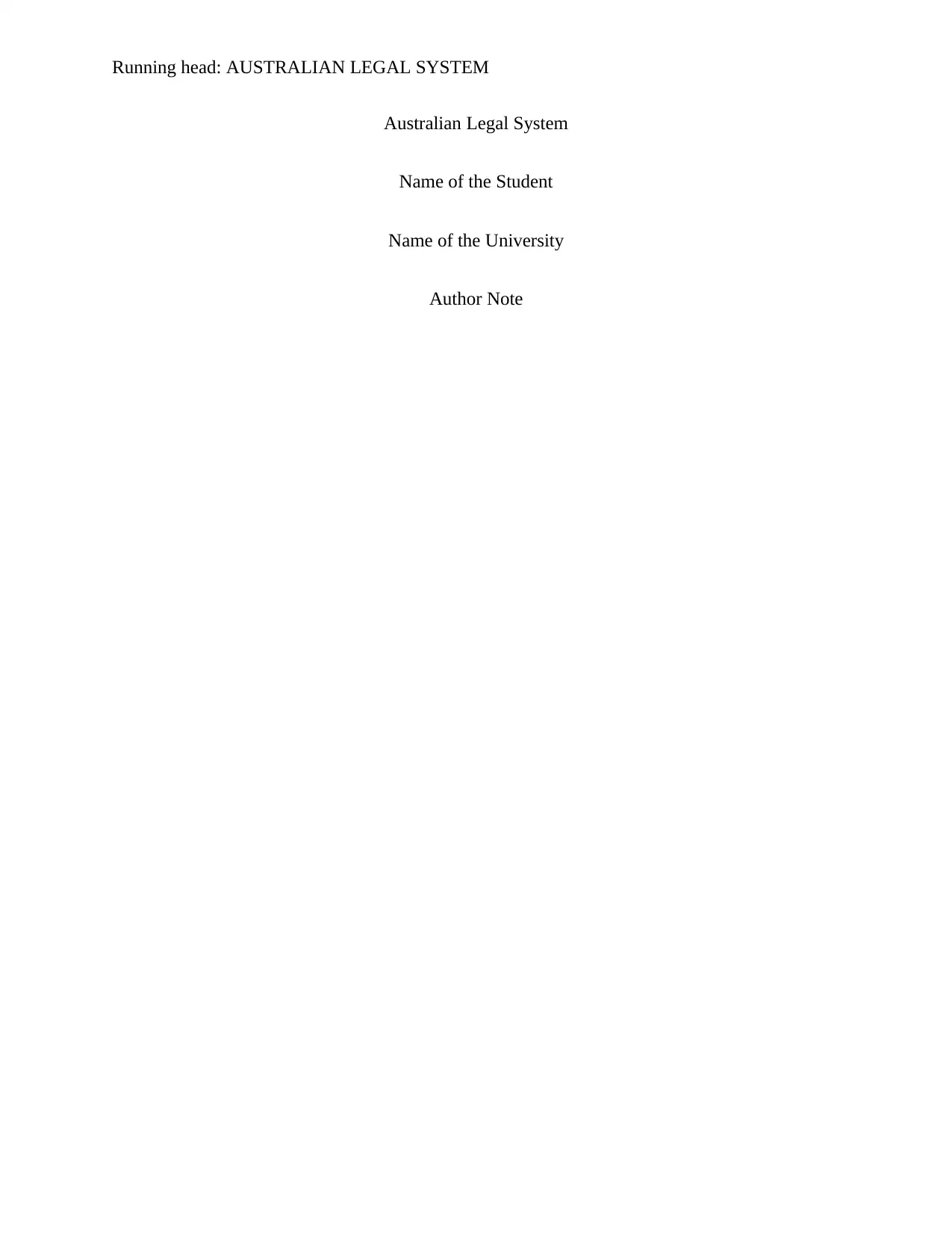
Running head: AUSTRALIAN LEGAL SYSTEM
Australian Legal System
Name of the Student
Name of the University
Author Note
Australian Legal System
Name of the Student
Name of the University
Author Note
Paraphrase This Document
Need a fresh take? Get an instant paraphrase of this document with our AI Paraphraser
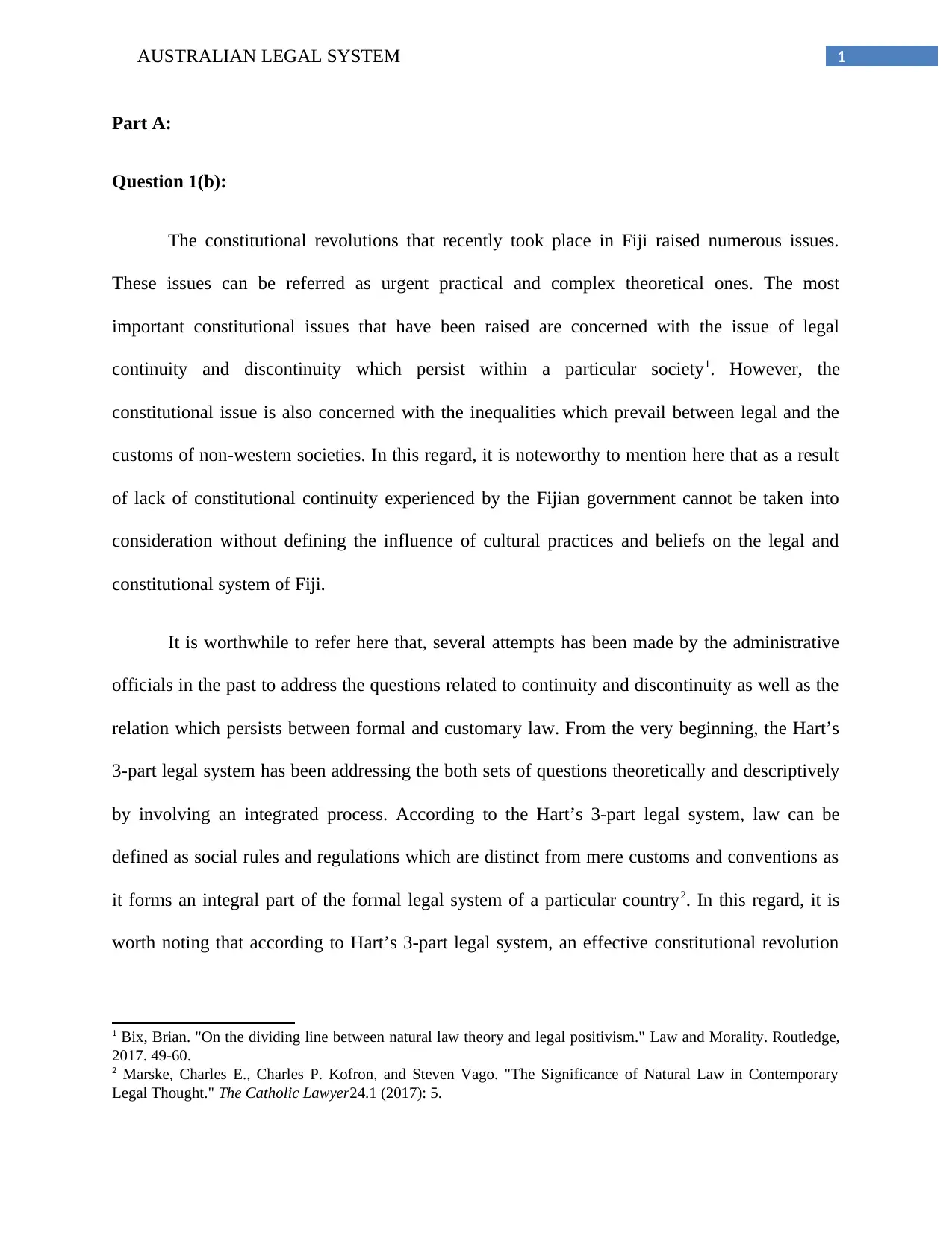
1AUSTRALIAN LEGAL SYSTEM
Part A:
Question 1(b):
The constitutional revolutions that recently took place in Fiji raised numerous issues.
These issues can be referred as urgent practical and complex theoretical ones. The most
important constitutional issues that have been raised are concerned with the issue of legal
continuity and discontinuity which persist within a particular society1. However, the
constitutional issue is also concerned with the inequalities which prevail between legal and the
customs of non-western societies. In this regard, it is noteworthy to mention here that as a result
of lack of constitutional continuity experienced by the Fijian government cannot be taken into
consideration without defining the influence of cultural practices and beliefs on the legal and
constitutional system of Fiji.
It is worthwhile to refer here that, several attempts has been made by the administrative
officials in the past to address the questions related to continuity and discontinuity as well as the
relation which persists between formal and customary law. From the very beginning, the Hart’s
3-part legal system has been addressing the both sets of questions theoretically and descriptively
by involving an integrated process. According to the Hart’s 3-part legal system, law can be
defined as social rules and regulations which are distinct from mere customs and conventions as
it forms an integral part of the formal legal system of a particular country2. In this regard, it is
worth noting that according to Hart’s 3-part legal system, an effective constitutional revolution
1 Bix, Brian. "On the dividing line between natural law theory and legal positivism." Law and Morality. Routledge,
2017. 49-60.
2 Marske, Charles E., Charles P. Kofron, and Steven Vago. "The Significance of Natural Law in Contemporary
Legal Thought." The Catholic Lawyer24.1 (2017): 5.
Part A:
Question 1(b):
The constitutional revolutions that recently took place in Fiji raised numerous issues.
These issues can be referred as urgent practical and complex theoretical ones. The most
important constitutional issues that have been raised are concerned with the issue of legal
continuity and discontinuity which persist within a particular society1. However, the
constitutional issue is also concerned with the inequalities which prevail between legal and the
customs of non-western societies. In this regard, it is noteworthy to mention here that as a result
of lack of constitutional continuity experienced by the Fijian government cannot be taken into
consideration without defining the influence of cultural practices and beliefs on the legal and
constitutional system of Fiji.
It is worthwhile to refer here that, several attempts has been made by the administrative
officials in the past to address the questions related to continuity and discontinuity as well as the
relation which persists between formal and customary law. From the very beginning, the Hart’s
3-part legal system has been addressing the both sets of questions theoretically and descriptively
by involving an integrated process. According to the Hart’s 3-part legal system, law can be
defined as social rules and regulations which are distinct from mere customs and conventions as
it forms an integral part of the formal legal system of a particular country2. In this regard, it is
worth noting that according to Hart’s 3-part legal system, an effective constitutional revolution
1 Bix, Brian. "On the dividing line between natural law theory and legal positivism." Law and Morality. Routledge,
2017. 49-60.
2 Marske, Charles E., Charles P. Kofron, and Steven Vago. "The Significance of Natural Law in Contemporary
Legal Thought." The Catholic Lawyer24.1 (2017): 5.
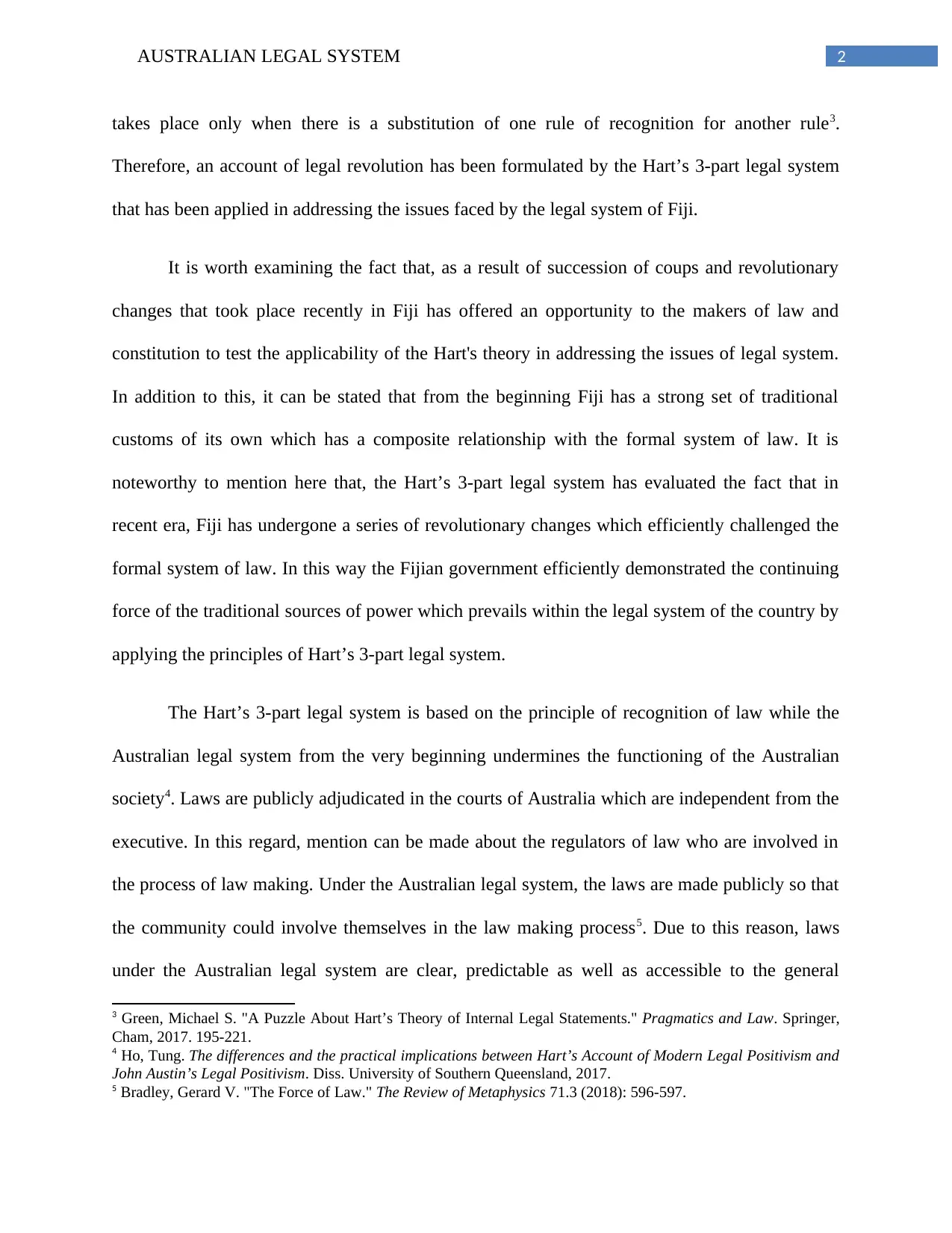
2AUSTRALIAN LEGAL SYSTEM
takes place only when there is a substitution of one rule of recognition for another rule3.
Therefore, an account of legal revolution has been formulated by the Hart’s 3-part legal system
that has been applied in addressing the issues faced by the legal system of Fiji.
It is worth examining the fact that, as a result of succession of coups and revolutionary
changes that took place recently in Fiji has offered an opportunity to the makers of law and
constitution to test the applicability of the Hart's theory in addressing the issues of legal system.
In addition to this, it can be stated that from the beginning Fiji has a strong set of traditional
customs of its own which has a composite relationship with the formal system of law. It is
noteworthy to mention here that, the Hart’s 3-part legal system has evaluated the fact that in
recent era, Fiji has undergone a series of revolutionary changes which efficiently challenged the
formal system of law. In this way the Fijian government efficiently demonstrated the continuing
force of the traditional sources of power which prevails within the legal system of the country by
applying the principles of Hart’s 3-part legal system.
The Hart’s 3-part legal system is based on the principle of recognition of law while the
Australian legal system from the very beginning undermines the functioning of the Australian
society4. Laws are publicly adjudicated in the courts of Australia which are independent from the
executive. In this regard, mention can be made about the regulators of law who are involved in
the process of law making. Under the Australian legal system, the laws are made publicly so that
the community could involve themselves in the law making process5. Due to this reason, laws
under the Australian legal system are clear, predictable as well as accessible to the general
3 Green, Michael S. "A Puzzle About Hart’s Theory of Internal Legal Statements." Pragmatics and Law. Springer,
Cham, 2017. 195-221.
4 Ho, Tung. The differences and the practical implications between Hart’s Account of Modern Legal Positivism and
John Austin’s Legal Positivism. Diss. University of Southern Queensland, 2017.
5 Bradley, Gerard V. "The Force of Law." The Review of Metaphysics 71.3 (2018): 596-597.
takes place only when there is a substitution of one rule of recognition for another rule3.
Therefore, an account of legal revolution has been formulated by the Hart’s 3-part legal system
that has been applied in addressing the issues faced by the legal system of Fiji.
It is worth examining the fact that, as a result of succession of coups and revolutionary
changes that took place recently in Fiji has offered an opportunity to the makers of law and
constitution to test the applicability of the Hart's theory in addressing the issues of legal system.
In addition to this, it can be stated that from the beginning Fiji has a strong set of traditional
customs of its own which has a composite relationship with the formal system of law. It is
noteworthy to mention here that, the Hart’s 3-part legal system has evaluated the fact that in
recent era, Fiji has undergone a series of revolutionary changes which efficiently challenged the
formal system of law. In this way the Fijian government efficiently demonstrated the continuing
force of the traditional sources of power which prevails within the legal system of the country by
applying the principles of Hart’s 3-part legal system.
The Hart’s 3-part legal system is based on the principle of recognition of law while the
Australian legal system from the very beginning undermines the functioning of the Australian
society4. Laws are publicly adjudicated in the courts of Australia which are independent from the
executive. In this regard, mention can be made about the regulators of law who are involved in
the process of law making. Under the Australian legal system, the laws are made publicly so that
the community could involve themselves in the law making process5. Due to this reason, laws
under the Australian legal system are clear, predictable as well as accessible to the general
3 Green, Michael S. "A Puzzle About Hart’s Theory of Internal Legal Statements." Pragmatics and Law. Springer,
Cham, 2017. 195-221.
4 Ho, Tung. The differences and the practical implications between Hart’s Account of Modern Legal Positivism and
John Austin’s Legal Positivism. Diss. University of Southern Queensland, 2017.
5 Bradley, Gerard V. "The Force of Law." The Review of Metaphysics 71.3 (2018): 596-597.
⊘ This is a preview!⊘
Do you want full access?
Subscribe today to unlock all pages.

Trusted by 1+ million students worldwide
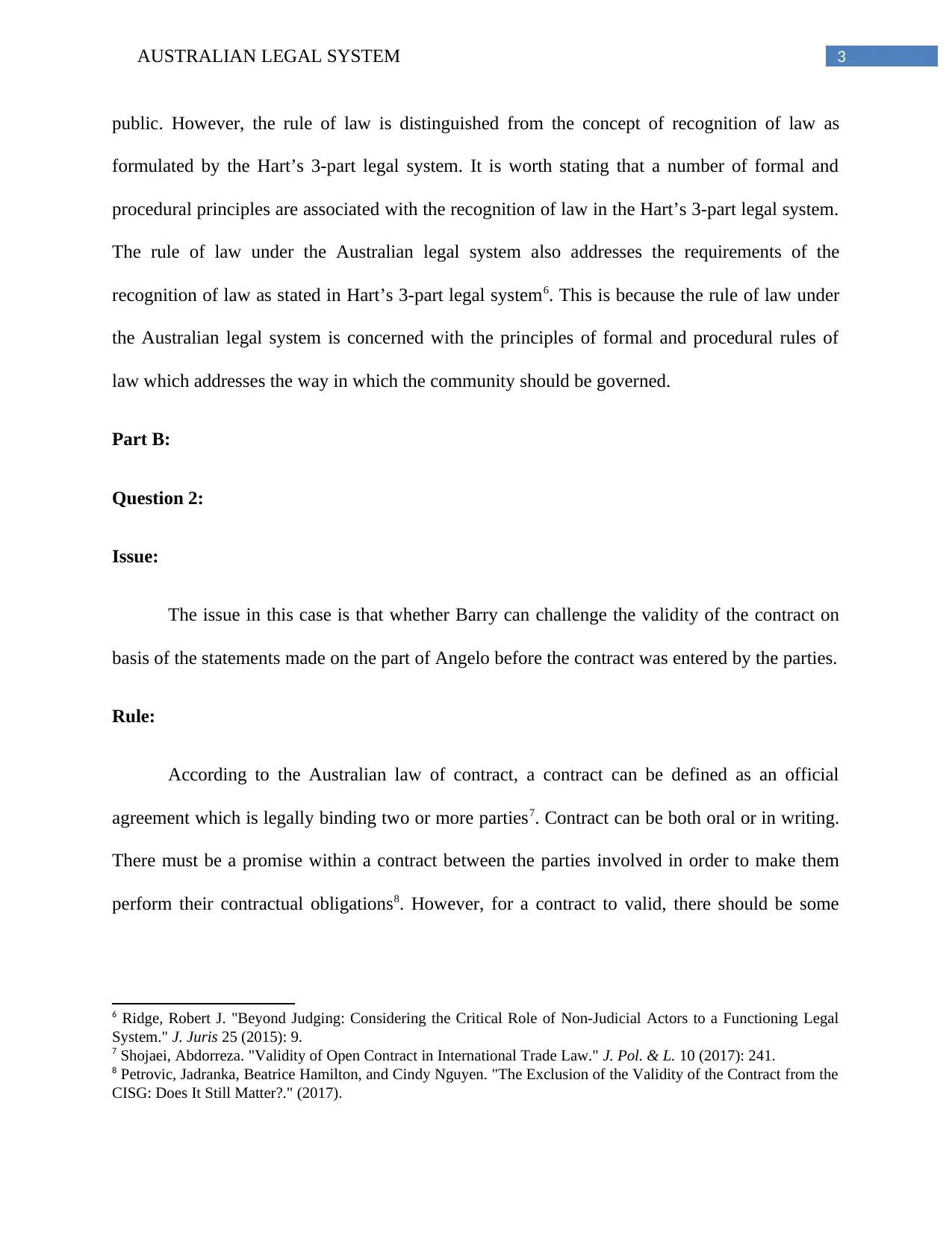
3AUSTRALIAN LEGAL SYSTEM
public. However, the rule of law is distinguished from the concept of recognition of law as
formulated by the Hart’s 3-part legal system. It is worth stating that a number of formal and
procedural principles are associated with the recognition of law in the Hart’s 3-part legal system.
The rule of law under the Australian legal system also addresses the requirements of the
recognition of law as stated in Hart’s 3-part legal system6. This is because the rule of law under
the Australian legal system is concerned with the principles of formal and procedural rules of
law which addresses the way in which the community should be governed.
Part B:
Question 2:
Issue:
The issue in this case is that whether Barry can challenge the validity of the contract on
basis of the statements made on the part of Angelo before the contract was entered by the parties.
Rule:
According to the Australian law of contract, a contract can be defined as an official
agreement which is legally binding two or more parties7. Contract can be both oral or in writing.
There must be a promise within a contract between the parties involved in order to make them
perform their contractual obligations8. However, for a contract to valid, there should be some
6 Ridge, Robert J. "Beyond Judging: Considering the Critical Role of Non-Judicial Actors to a Functioning Legal
System." J. Juris 25 (2015): 9.
7 Shojaei, Abdorreza. "Validity of Open Contract in International Trade Law." J. Pol. & L. 10 (2017): 241.
8 Petrovic, Jadranka, Beatrice Hamilton, and Cindy Nguyen. "The Exclusion of the Validity of the Contract from the
CISG: Does It Still Matter?." (2017).
public. However, the rule of law is distinguished from the concept of recognition of law as
formulated by the Hart’s 3-part legal system. It is worth stating that a number of formal and
procedural principles are associated with the recognition of law in the Hart’s 3-part legal system.
The rule of law under the Australian legal system also addresses the requirements of the
recognition of law as stated in Hart’s 3-part legal system6. This is because the rule of law under
the Australian legal system is concerned with the principles of formal and procedural rules of
law which addresses the way in which the community should be governed.
Part B:
Question 2:
Issue:
The issue in this case is that whether Barry can challenge the validity of the contract on
basis of the statements made on the part of Angelo before the contract was entered by the parties.
Rule:
According to the Australian law of contract, a contract can be defined as an official
agreement which is legally binding two or more parties7. Contract can be both oral or in writing.
There must be a promise within a contract between the parties involved in order to make them
perform their contractual obligations8. However, for a contract to valid, there should be some
6 Ridge, Robert J. "Beyond Judging: Considering the Critical Role of Non-Judicial Actors to a Functioning Legal
System." J. Juris 25 (2015): 9.
7 Shojaei, Abdorreza. "Validity of Open Contract in International Trade Law." J. Pol. & L. 10 (2017): 241.
8 Petrovic, Jadranka, Beatrice Hamilton, and Cindy Nguyen. "The Exclusion of the Validity of the Contract from the
CISG: Does It Still Matter?." (2017).
Paraphrase This Document
Need a fresh take? Get an instant paraphrase of this document with our AI Paraphraser
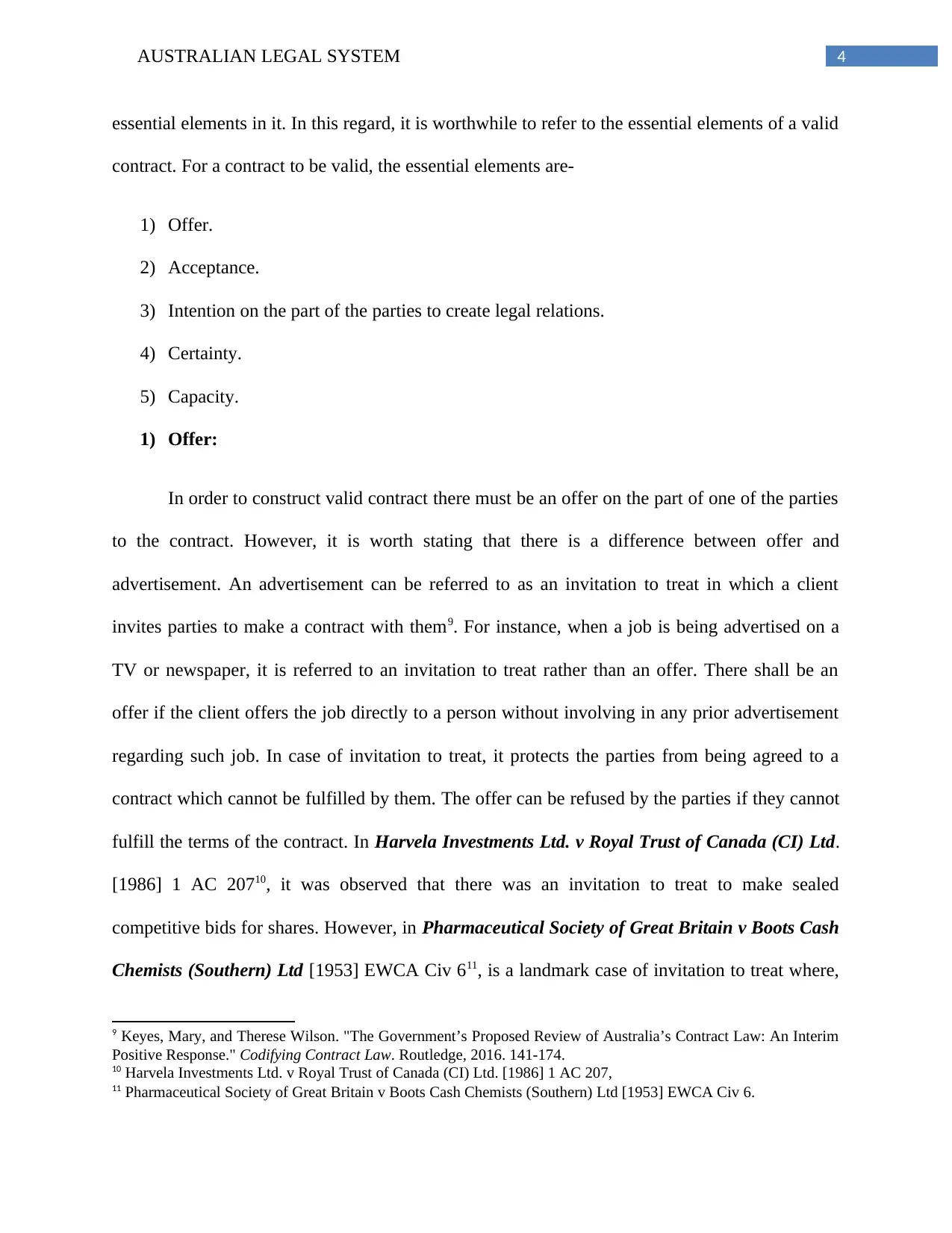
4AUSTRALIAN LEGAL SYSTEM
essential elements in it. In this regard, it is worthwhile to refer to the essential elements of a valid
contract. For a contract to be valid, the essential elements are-
1) Offer.
2) Acceptance.
3) Intention on the part of the parties to create legal relations.
4) Certainty.
5) Capacity.
1) Offer:
In order to construct valid contract there must be an offer on the part of one of the parties
to the contract. However, it is worth stating that there is a difference between offer and
advertisement. An advertisement can be referred to as an invitation to treat in which a client
invites parties to make a contract with them9. For instance, when a job is being advertised on a
TV or newspaper, it is referred to an invitation to treat rather than an offer. There shall be an
offer if the client offers the job directly to a person without involving in any prior advertisement
regarding such job. In case of invitation to treat, it protects the parties from being agreed to a
contract which cannot be fulfilled by them. The offer can be refused by the parties if they cannot
fulfill the terms of the contract. In Harvela Investments Ltd. v Royal Trust of Canada (CI) Ltd.
[1986] 1 AC 20710, it was observed that there was an invitation to treat to make sealed
competitive bids for shares. However, in Pharmaceutical Society of Great Britain v Boots Cash
Chemists (Southern) Ltd [1953] EWCA Civ 611, is a landmark case of invitation to treat where,
9 Keyes, Mary, and Therese Wilson. "The Government’s Proposed Review of Australia’s Contract Law: An Interim
Positive Response." Codifying Contract Law. Routledge, 2016. 141-174.
10 Harvela Investments Ltd. v Royal Trust of Canada (CI) Ltd. [1986] 1 AC 207,
11 Pharmaceutical Society of Great Britain v Boots Cash Chemists (Southern) Ltd [1953] EWCA Civ 6.
essential elements in it. In this regard, it is worthwhile to refer to the essential elements of a valid
contract. For a contract to be valid, the essential elements are-
1) Offer.
2) Acceptance.
3) Intention on the part of the parties to create legal relations.
4) Certainty.
5) Capacity.
1) Offer:
In order to construct valid contract there must be an offer on the part of one of the parties
to the contract. However, it is worth stating that there is a difference between offer and
advertisement. An advertisement can be referred to as an invitation to treat in which a client
invites parties to make a contract with them9. For instance, when a job is being advertised on a
TV or newspaper, it is referred to an invitation to treat rather than an offer. There shall be an
offer if the client offers the job directly to a person without involving in any prior advertisement
regarding such job. In case of invitation to treat, it protects the parties from being agreed to a
contract which cannot be fulfilled by them. The offer can be refused by the parties if they cannot
fulfill the terms of the contract. In Harvela Investments Ltd. v Royal Trust of Canada (CI) Ltd.
[1986] 1 AC 20710, it was observed that there was an invitation to treat to make sealed
competitive bids for shares. However, in Pharmaceutical Society of Great Britain v Boots Cash
Chemists (Southern) Ltd [1953] EWCA Civ 611, is a landmark case of invitation to treat where,
9 Keyes, Mary, and Therese Wilson. "The Government’s Proposed Review of Australia’s Contract Law: An Interim
Positive Response." Codifying Contract Law. Routledge, 2016. 141-174.
10 Harvela Investments Ltd. v Royal Trust of Canada (CI) Ltd. [1986] 1 AC 207,
11 Pharmaceutical Society of Great Britain v Boots Cash Chemists (Southern) Ltd [1953] EWCA Civ 6.

5AUSTRALIAN LEGAL SYSTEM
the customers offered on their part to buy the store. Therefore, there was an option on the part of
the buyers to buy the store or not.
In this regard, it can be stated that clients and contractors should be aware of the valid
rules of offer and acceptance as well as invitation to treat12. However, offer and acceptance are
essential part of a contract and without these there shall be no contract.
2) Acceptance:
When an offer is made by one of the parties to the contract, there should be an acceptance
on the part of the other party. However, it is important on the part of the party making the
acceptance to understand what is being offered in order to be clear with the terms and conditions.
3) Consideration:
Consideration forms an essential part of contract which is related to the fact that in order
to form a valid contract, something should be given in return.
4) Intention to create legal relations:
There must be a common intention of the parties to make the contract legally enforceable.
5) Certainty:
It is important that the terms and conditions of the contract should be clearly and
accurately stated. In this regard, it is worth noting that if the terms of the agreement are not
certain then it is not a valid contract.
12 Shenghua, J. I. A. N. G. "An Analysis on Validity of Unauthorized Disposition Contract." Journal of Hefei
Normal University 2 (2015): 014.
the customers offered on their part to buy the store. Therefore, there was an option on the part of
the buyers to buy the store or not.
In this regard, it can be stated that clients and contractors should be aware of the valid
rules of offer and acceptance as well as invitation to treat12. However, offer and acceptance are
essential part of a contract and without these there shall be no contract.
2) Acceptance:
When an offer is made by one of the parties to the contract, there should be an acceptance
on the part of the other party. However, it is important on the part of the party making the
acceptance to understand what is being offered in order to be clear with the terms and conditions.
3) Consideration:
Consideration forms an essential part of contract which is related to the fact that in order
to form a valid contract, something should be given in return.
4) Intention to create legal relations:
There must be a common intention of the parties to make the contract legally enforceable.
5) Certainty:
It is important that the terms and conditions of the contract should be clearly and
accurately stated. In this regard, it is worth noting that if the terms of the agreement are not
certain then it is not a valid contract.
12 Shenghua, J. I. A. N. G. "An Analysis on Validity of Unauthorized Disposition Contract." Journal of Hefei
Normal University 2 (2015): 014.
⊘ This is a preview!⊘
Do you want full access?
Subscribe today to unlock all pages.

Trusted by 1+ million students worldwide

6AUSTRALIAN LEGAL SYSTEM
6) Capacity:
The parties must have a capacity to enter into a contract. Therefore, unsound persons
cannot enter into a contract because it will be considered as invalid.
Application:
In the present scenario, it can be observed that there was an invitation to treat on the part
of Angelo. Therefore, there was an option available to Barry that whether he would accept the
offer or not. In this regard, the case of Pharmaceutical Society of Great Britain v Boots Cash
Chemists (Southern) Ltd [1953] EWCA Civ 6 and Harvela Investments Ltd. v Royal Trust of
Canada (CI) Ltd. [1986] 1 AC 207 can be applied. This is because; there is a difference between
offer and invitation to treat about which Barry was not aware. In this case, there was an
acceptance on the part of Barry when a contract was signed between him and Angelo. There was
also a consideration on the part of Barry when he paid a sum of $200,000. There was also an
intention to create legal relationship and the parties were capable to enter into the contract.
However, the terms and conditions of the contract were not certain which included the expenses
of the business, the competitors and the turnover. As a result of uncertainty in the terms of the
contract Barry had to suffer in business also there was no mention of the lease of the van and the
condition of the loader.
Conclusion:
In the conclusion, it can be stated that Barry could challenge the validity of the contract
on the grounds of certainty which is an important essential of valid contract.
Question 3:
6) Capacity:
The parties must have a capacity to enter into a contract. Therefore, unsound persons
cannot enter into a contract because it will be considered as invalid.
Application:
In the present scenario, it can be observed that there was an invitation to treat on the part
of Angelo. Therefore, there was an option available to Barry that whether he would accept the
offer or not. In this regard, the case of Pharmaceutical Society of Great Britain v Boots Cash
Chemists (Southern) Ltd [1953] EWCA Civ 6 and Harvela Investments Ltd. v Royal Trust of
Canada (CI) Ltd. [1986] 1 AC 207 can be applied. This is because; there is a difference between
offer and invitation to treat about which Barry was not aware. In this case, there was an
acceptance on the part of Barry when a contract was signed between him and Angelo. There was
also a consideration on the part of Barry when he paid a sum of $200,000. There was also an
intention to create legal relationship and the parties were capable to enter into the contract.
However, the terms and conditions of the contract were not certain which included the expenses
of the business, the competitors and the turnover. As a result of uncertainty in the terms of the
contract Barry had to suffer in business also there was no mention of the lease of the van and the
condition of the loader.
Conclusion:
In the conclusion, it can be stated that Barry could challenge the validity of the contract
on the grounds of certainty which is an important essential of valid contract.
Question 3:
Paraphrase This Document
Need a fresh take? Get an instant paraphrase of this document with our AI Paraphraser
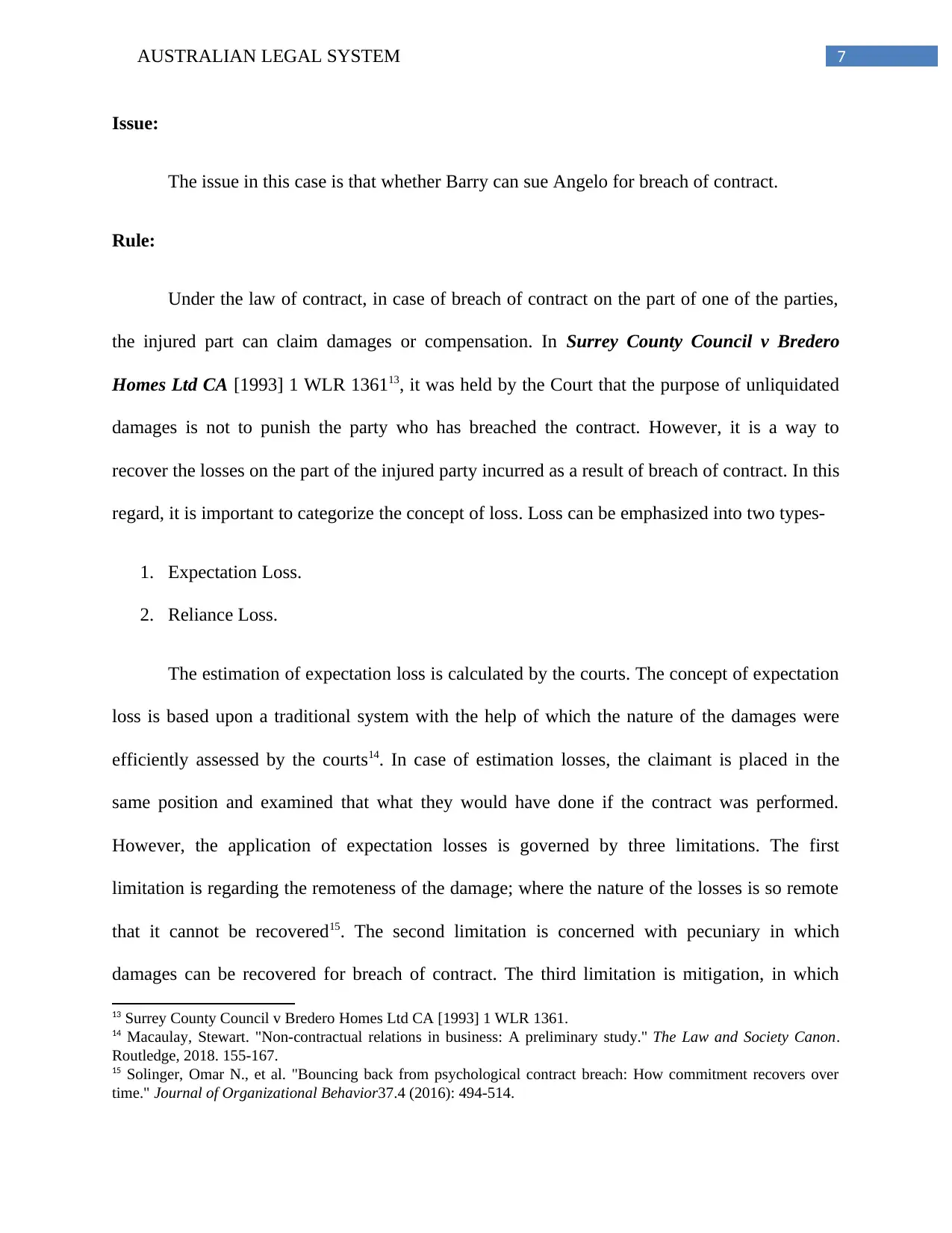
7AUSTRALIAN LEGAL SYSTEM
Issue:
The issue in this case is that whether Barry can sue Angelo for breach of contract.
Rule:
Under the law of contract, in case of breach of contract on the part of one of the parties,
the injured part can claim damages or compensation. In Surrey County Council v Bredero
Homes Ltd CA [1993] 1 WLR 136113, it was held by the Court that the purpose of unliquidated
damages is not to punish the party who has breached the contract. However, it is a way to
recover the losses on the part of the injured party incurred as a result of breach of contract. In this
regard, it is important to categorize the concept of loss. Loss can be emphasized into two types-
1. Expectation Loss.
2. Reliance Loss.
The estimation of expectation loss is calculated by the courts. The concept of expectation
loss is based upon a traditional system with the help of which the nature of the damages were
efficiently assessed by the courts14. In case of estimation losses, the claimant is placed in the
same position and examined that what they would have done if the contract was performed.
However, the application of expectation losses is governed by three limitations. The first
limitation is regarding the remoteness of the damage; where the nature of the losses is so remote
that it cannot be recovered15. The second limitation is concerned with pecuniary in which
damages can be recovered for breach of contract. The third limitation is mitigation, in which
13 Surrey County Council v Bredero Homes Ltd CA [1993] 1 WLR 1361.
14 Macaulay, Stewart. "Non-contractual relations in business: A preliminary study." The Law and Society Canon.
Routledge, 2018. 155-167.
15 Solinger, Omar N., et al. "Bouncing back from psychological contract breach: How commitment recovers over
time." Journal of Organizational Behavior37.4 (2016): 494-514.
Issue:
The issue in this case is that whether Barry can sue Angelo for breach of contract.
Rule:
Under the law of contract, in case of breach of contract on the part of one of the parties,
the injured part can claim damages or compensation. In Surrey County Council v Bredero
Homes Ltd CA [1993] 1 WLR 136113, it was held by the Court that the purpose of unliquidated
damages is not to punish the party who has breached the contract. However, it is a way to
recover the losses on the part of the injured party incurred as a result of breach of contract. In this
regard, it is important to categorize the concept of loss. Loss can be emphasized into two types-
1. Expectation Loss.
2. Reliance Loss.
The estimation of expectation loss is calculated by the courts. The concept of expectation
loss is based upon a traditional system with the help of which the nature of the damages were
efficiently assessed by the courts14. In case of estimation losses, the claimant is placed in the
same position and examined that what they would have done if the contract was performed.
However, the application of expectation losses is governed by three limitations. The first
limitation is regarding the remoteness of the damage; where the nature of the losses is so remote
that it cannot be recovered15. The second limitation is concerned with pecuniary in which
damages can be recovered for breach of contract. The third limitation is mitigation, in which
13 Surrey County Council v Bredero Homes Ltd CA [1993] 1 WLR 1361.
14 Macaulay, Stewart. "Non-contractual relations in business: A preliminary study." The Law and Society Canon.
Routledge, 2018. 155-167.
15 Solinger, Omar N., et al. "Bouncing back from psychological contract breach: How commitment recovers over
time." Journal of Organizational Behavior37.4 (2016): 494-514.
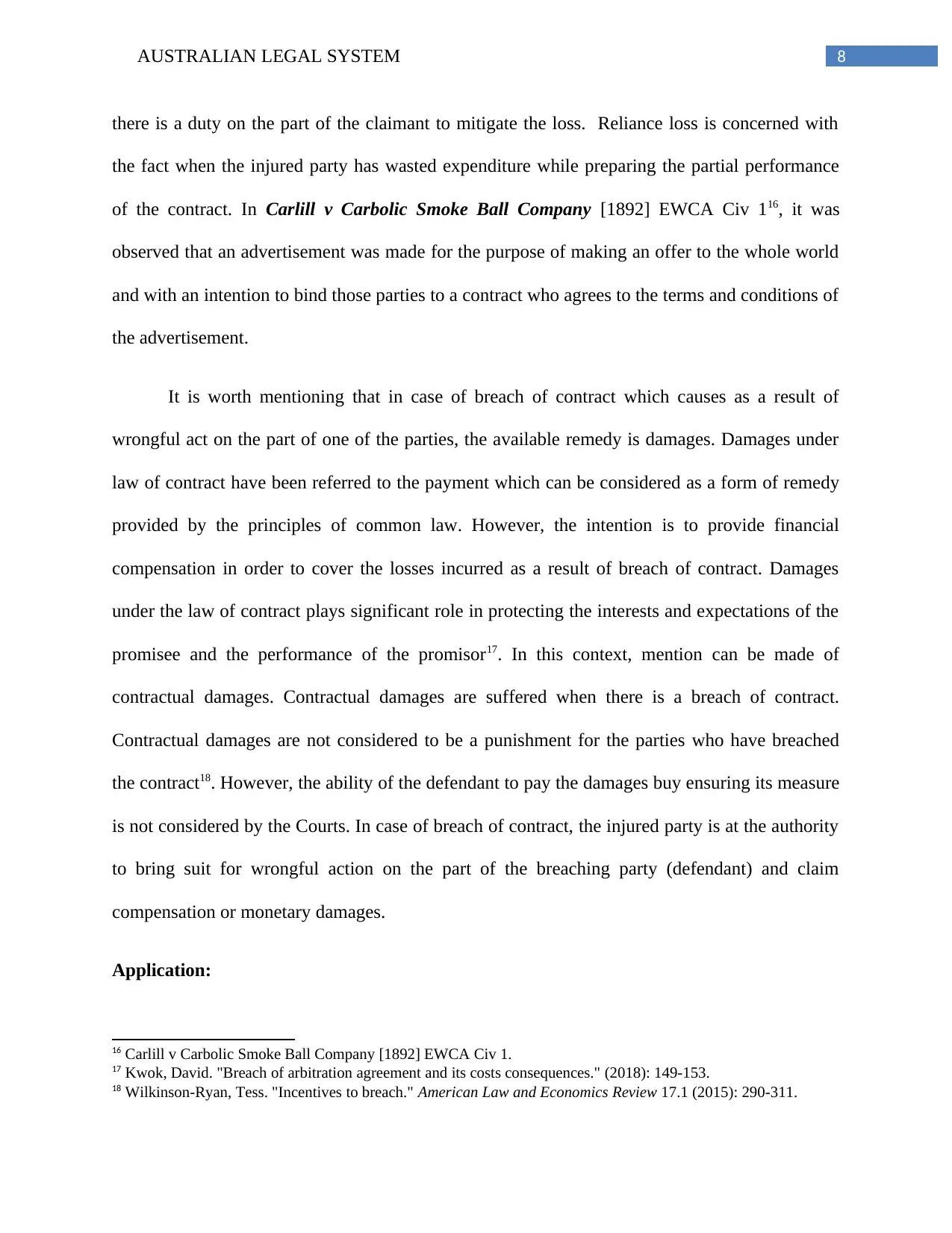
8AUSTRALIAN LEGAL SYSTEM
there is a duty on the part of the claimant to mitigate the loss. Reliance loss is concerned with
the fact when the injured party has wasted expenditure while preparing the partial performance
of the contract. In Carlill v Carbolic Smoke Ball Company [1892] EWCA Civ 116, it was
observed that an advertisement was made for the purpose of making an offer to the whole world
and with an intention to bind those parties to a contract who agrees to the terms and conditions of
the advertisement.
It is worth mentioning that in case of breach of contract which causes as a result of
wrongful act on the part of one of the parties, the available remedy is damages. Damages under
law of contract have been referred to the payment which can be considered as a form of remedy
provided by the principles of common law. However, the intention is to provide financial
compensation in order to cover the losses incurred as a result of breach of contract. Damages
under the law of contract plays significant role in protecting the interests and expectations of the
promisee and the performance of the promisor17. In this context, mention can be made of
contractual damages. Contractual damages are suffered when there is a breach of contract.
Contractual damages are not considered to be a punishment for the parties who have breached
the contract18. However, the ability of the defendant to pay the damages buy ensuring its measure
is not considered by the Courts. In case of breach of contract, the injured party is at the authority
to bring suit for wrongful action on the part of the breaching party (defendant) and claim
compensation or monetary damages.
Application:
16 Carlill v Carbolic Smoke Ball Company [1892] EWCA Civ 1.
17 Kwok, David. "Breach of arbitration agreement and its costs consequences." (2018): 149-153.
18 Wilkinson-Ryan, Tess. "Incentives to breach." American Law and Economics Review 17.1 (2015): 290-311.
there is a duty on the part of the claimant to mitigate the loss. Reliance loss is concerned with
the fact when the injured party has wasted expenditure while preparing the partial performance
of the contract. In Carlill v Carbolic Smoke Ball Company [1892] EWCA Civ 116, it was
observed that an advertisement was made for the purpose of making an offer to the whole world
and with an intention to bind those parties to a contract who agrees to the terms and conditions of
the advertisement.
It is worth mentioning that in case of breach of contract which causes as a result of
wrongful act on the part of one of the parties, the available remedy is damages. Damages under
law of contract have been referred to the payment which can be considered as a form of remedy
provided by the principles of common law. However, the intention is to provide financial
compensation in order to cover the losses incurred as a result of breach of contract. Damages
under the law of contract plays significant role in protecting the interests and expectations of the
promisee and the performance of the promisor17. In this context, mention can be made of
contractual damages. Contractual damages are suffered when there is a breach of contract.
Contractual damages are not considered to be a punishment for the parties who have breached
the contract18. However, the ability of the defendant to pay the damages buy ensuring its measure
is not considered by the Courts. In case of breach of contract, the injured party is at the authority
to bring suit for wrongful action on the part of the breaching party (defendant) and claim
compensation or monetary damages.
Application:
16 Carlill v Carbolic Smoke Ball Company [1892] EWCA Civ 1.
17 Kwok, David. "Breach of arbitration agreement and its costs consequences." (2018): 149-153.
18 Wilkinson-Ryan, Tess. "Incentives to breach." American Law and Economics Review 17.1 (2015): 290-311.
⊘ This is a preview!⊘
Do you want full access?
Subscribe today to unlock all pages.

Trusted by 1+ million students worldwide
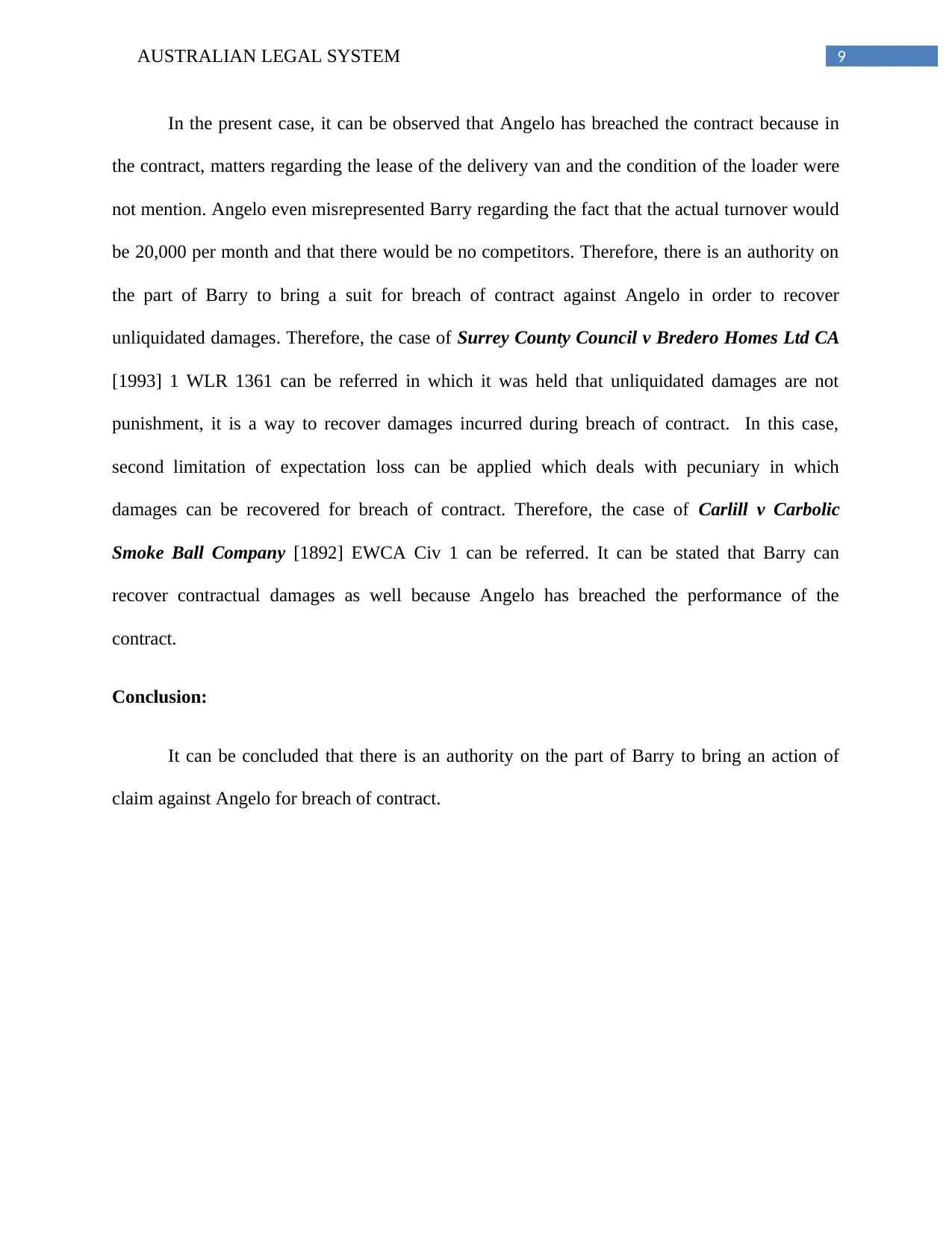
9AUSTRALIAN LEGAL SYSTEM
In the present case, it can be observed that Angelo has breached the contract because in
the contract, matters regarding the lease of the delivery van and the condition of the loader were
not mention. Angelo even misrepresented Barry regarding the fact that the actual turnover would
be 20,000 per month and that there would be no competitors. Therefore, there is an authority on
the part of Barry to bring a suit for breach of contract against Angelo in order to recover
unliquidated damages. Therefore, the case of Surrey County Council v Bredero Homes Ltd CA
[1993] 1 WLR 1361 can be referred in which it was held that unliquidated damages are not
punishment, it is a way to recover damages incurred during breach of contract. In this case,
second limitation of expectation loss can be applied which deals with pecuniary in which
damages can be recovered for breach of contract. Therefore, the case of Carlill v Carbolic
Smoke Ball Company [1892] EWCA Civ 1 can be referred. It can be stated that Barry can
recover contractual damages as well because Angelo has breached the performance of the
contract.
Conclusion:
It can be concluded that there is an authority on the part of Barry to bring an action of
claim against Angelo for breach of contract.
In the present case, it can be observed that Angelo has breached the contract because in
the contract, matters regarding the lease of the delivery van and the condition of the loader were
not mention. Angelo even misrepresented Barry regarding the fact that the actual turnover would
be 20,000 per month and that there would be no competitors. Therefore, there is an authority on
the part of Barry to bring a suit for breach of contract against Angelo in order to recover
unliquidated damages. Therefore, the case of Surrey County Council v Bredero Homes Ltd CA
[1993] 1 WLR 1361 can be referred in which it was held that unliquidated damages are not
punishment, it is a way to recover damages incurred during breach of contract. In this case,
second limitation of expectation loss can be applied which deals with pecuniary in which
damages can be recovered for breach of contract. Therefore, the case of Carlill v Carbolic
Smoke Ball Company [1892] EWCA Civ 1 can be referred. It can be stated that Barry can
recover contractual damages as well because Angelo has breached the performance of the
contract.
Conclusion:
It can be concluded that there is an authority on the part of Barry to bring an action of
claim against Angelo for breach of contract.
Paraphrase This Document
Need a fresh take? Get an instant paraphrase of this document with our AI Paraphraser

10AUSTRALIAN LEGAL SYSTEM
References:
Cases:
Carlill v Carbolic Smoke Ball Company [1892] EWCA Civ 1.
Harvela Investments Ltd. v Royal Trust of Canada (CI) Ltd. [1986] 1 AC 207,
Pharmaceutical Society of Great Britain v Boots Cash Chemists (Southern) Ltd [1953] EWCA
Civ 6.
Surrey County Council v Bredero Homes Ltd CA [1993] 1 WLR 1361.
Journals:
Bix, Brian. "On the dividing line between natural law theory and legal positivism." Law and
Morality. Routledge, 2017. 49-60.
Bradley, Gerard V. "The Force of Law." The Review of Metaphysics 71.3 (2018): 596-597.
Green, Michael S. "A Puzzle About Hart’s Theory of Internal Legal Statements." Pragmatics
and Law. Springer, Cham, 2017. 195-221.
Ho, Tung. The differences and the practical implications between Hart’s Account of Modern
Legal Positivism and John Austin’s Legal Positivism. Diss. University of Southern Queensland,
2017.
Keyes, Mary, and Therese Wilson. "The Government’s Proposed Review of Australia’s Contract
Law: An Interim Positive Response." Codifying Contract Law. Routledge, 2016. 141-174.
Kwok, David. "Breach of arbitration agreement and its costs consequences." (2018): 149-153.
References:
Cases:
Carlill v Carbolic Smoke Ball Company [1892] EWCA Civ 1.
Harvela Investments Ltd. v Royal Trust of Canada (CI) Ltd. [1986] 1 AC 207,
Pharmaceutical Society of Great Britain v Boots Cash Chemists (Southern) Ltd [1953] EWCA
Civ 6.
Surrey County Council v Bredero Homes Ltd CA [1993] 1 WLR 1361.
Journals:
Bix, Brian. "On the dividing line between natural law theory and legal positivism." Law and
Morality. Routledge, 2017. 49-60.
Bradley, Gerard V. "The Force of Law." The Review of Metaphysics 71.3 (2018): 596-597.
Green, Michael S. "A Puzzle About Hart’s Theory of Internal Legal Statements." Pragmatics
and Law. Springer, Cham, 2017. 195-221.
Ho, Tung. The differences and the practical implications between Hart’s Account of Modern
Legal Positivism and John Austin’s Legal Positivism. Diss. University of Southern Queensland,
2017.
Keyes, Mary, and Therese Wilson. "The Government’s Proposed Review of Australia’s Contract
Law: An Interim Positive Response." Codifying Contract Law. Routledge, 2016. 141-174.
Kwok, David. "Breach of arbitration agreement and its costs consequences." (2018): 149-153.
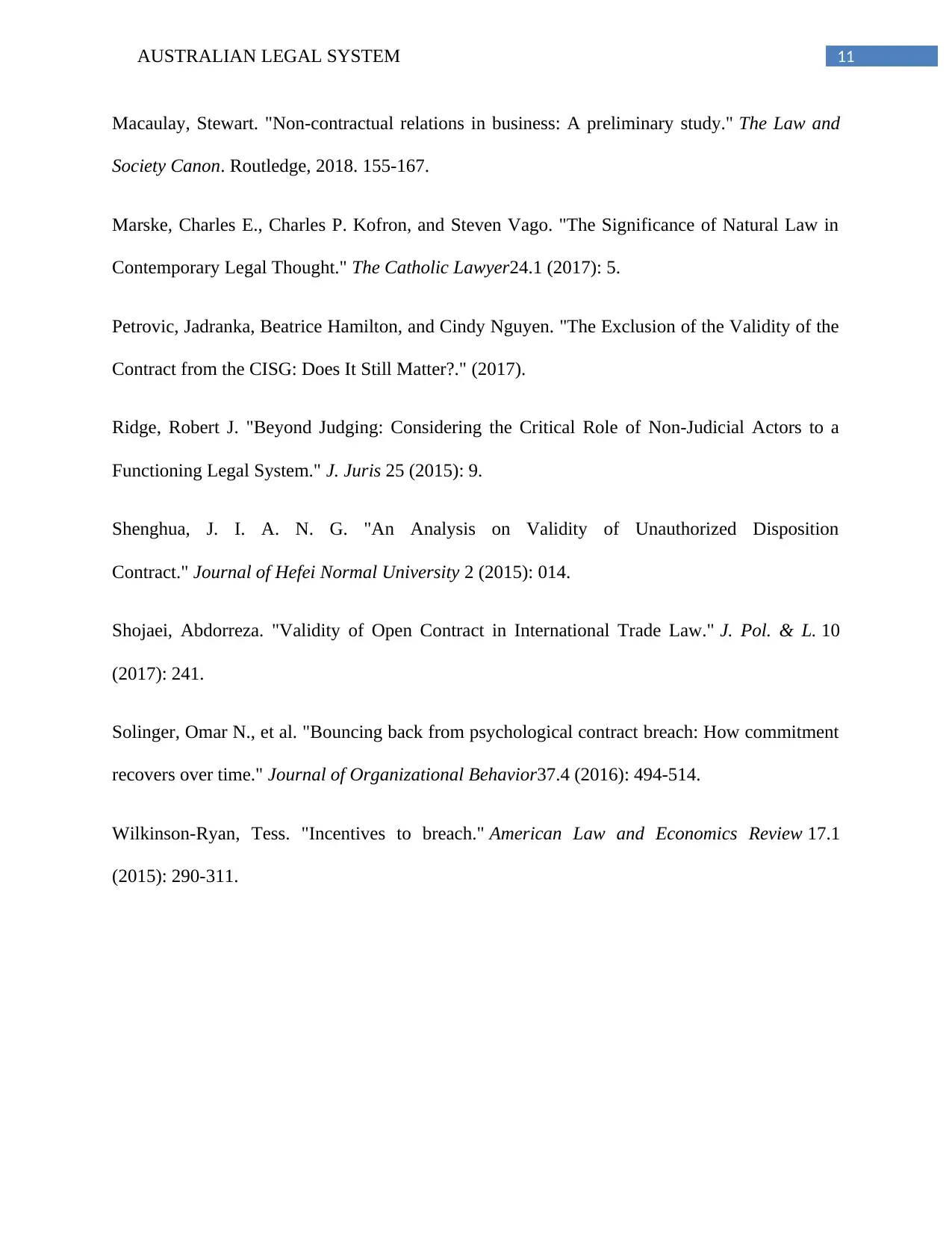
11AUSTRALIAN LEGAL SYSTEM
Macaulay, Stewart. "Non-contractual relations in business: A preliminary study." The Law and
Society Canon. Routledge, 2018. 155-167.
Marske, Charles E., Charles P. Kofron, and Steven Vago. "The Significance of Natural Law in
Contemporary Legal Thought." The Catholic Lawyer24.1 (2017): 5.
Petrovic, Jadranka, Beatrice Hamilton, and Cindy Nguyen. "The Exclusion of the Validity of the
Contract from the CISG: Does It Still Matter?." (2017).
Ridge, Robert J. "Beyond Judging: Considering the Critical Role of Non-Judicial Actors to a
Functioning Legal System." J. Juris 25 (2015): 9.
Shenghua, J. I. A. N. G. "An Analysis on Validity of Unauthorized Disposition
Contract." Journal of Hefei Normal University 2 (2015): 014.
Shojaei, Abdorreza. "Validity of Open Contract in International Trade Law." J. Pol. & L. 10
(2017): 241.
Solinger, Omar N., et al. "Bouncing back from psychological contract breach: How commitment
recovers over time." Journal of Organizational Behavior37.4 (2016): 494-514.
Wilkinson-Ryan, Tess. "Incentives to breach." American Law and Economics Review 17.1
(2015): 290-311.
Macaulay, Stewart. "Non-contractual relations in business: A preliminary study." The Law and
Society Canon. Routledge, 2018. 155-167.
Marske, Charles E., Charles P. Kofron, and Steven Vago. "The Significance of Natural Law in
Contemporary Legal Thought." The Catholic Lawyer24.1 (2017): 5.
Petrovic, Jadranka, Beatrice Hamilton, and Cindy Nguyen. "The Exclusion of the Validity of the
Contract from the CISG: Does It Still Matter?." (2017).
Ridge, Robert J. "Beyond Judging: Considering the Critical Role of Non-Judicial Actors to a
Functioning Legal System." J. Juris 25 (2015): 9.
Shenghua, J. I. A. N. G. "An Analysis on Validity of Unauthorized Disposition
Contract." Journal of Hefei Normal University 2 (2015): 014.
Shojaei, Abdorreza. "Validity of Open Contract in International Trade Law." J. Pol. & L. 10
(2017): 241.
Solinger, Omar N., et al. "Bouncing back from psychological contract breach: How commitment
recovers over time." Journal of Organizational Behavior37.4 (2016): 494-514.
Wilkinson-Ryan, Tess. "Incentives to breach." American Law and Economics Review 17.1
(2015): 290-311.
⊘ This is a preview!⊘
Do you want full access?
Subscribe today to unlock all pages.

Trusted by 1+ million students worldwide
1 out of 12
Your All-in-One AI-Powered Toolkit for Academic Success.
+13062052269
info@desklib.com
Available 24*7 on WhatsApp / Email
![[object Object]](/_next/static/media/star-bottom.7253800d.svg)
Unlock your academic potential
Copyright © 2020–2025 A2Z Services. All Rights Reserved. Developed and managed by ZUCOL.

